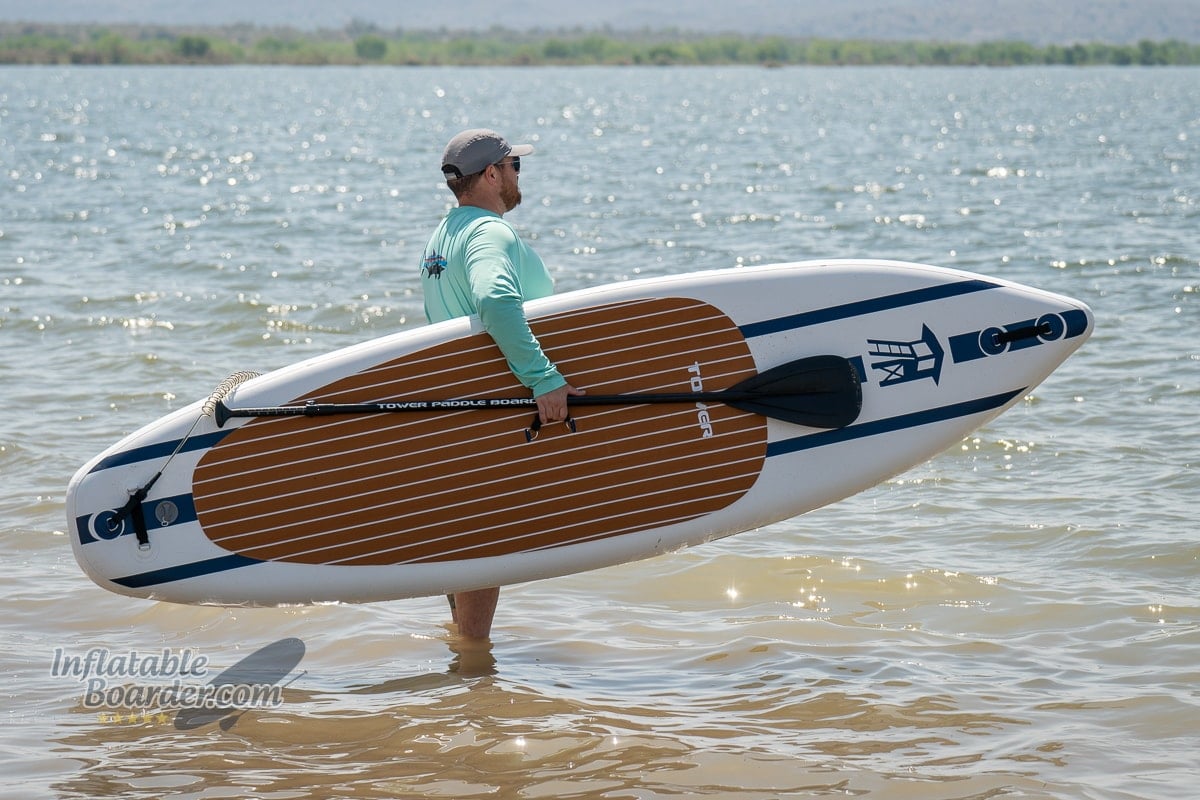
Tower Yachtsman iSUP: Overview
The Yachtsman is an all-around iSUP from long-time paddle board brand Tower. The Yachtsman shares the same basic shape and construction as Tower’s other “Premium Series” all-around iSUPs like the Mermaid and Adventurer 2, but with a different color scheme and absence of a cargo area built onto the board’s deck.
— Tower Yachtsman iSUP Summary Ratings and Review —
Tower Yachtsman
-
Construction & Durability
-
Features and Versatility
-
Stability
-
Speed
-
Maneuverability
-
Tracking
Overall Score
The Yachtsman is a no-frills all-around iSUP that includes a very basic kit of accessories
Pros
- Double-layer construction provides durability and rigidity
- Soft brushed EVA foam deck pad is comfortable to stand or sit on
- Easy to use fin system requires no tools for installation or removal
- 2 year warranty
Cons
- The lack of any cargo carrying ability is limiting
- The overall shape of the board could be tweaked to provide better stability
- The Yachtsman includes a basic kit of accessories, but does not include a leash or bag.
Construction and Durability
The Tower Yachtsman is part of Tower’s “Premium Series” iSUPs that use a hand-glued double layer construction. This provides good durability and decent rigidity at the recommended maximum 12 PSI internal pressure.
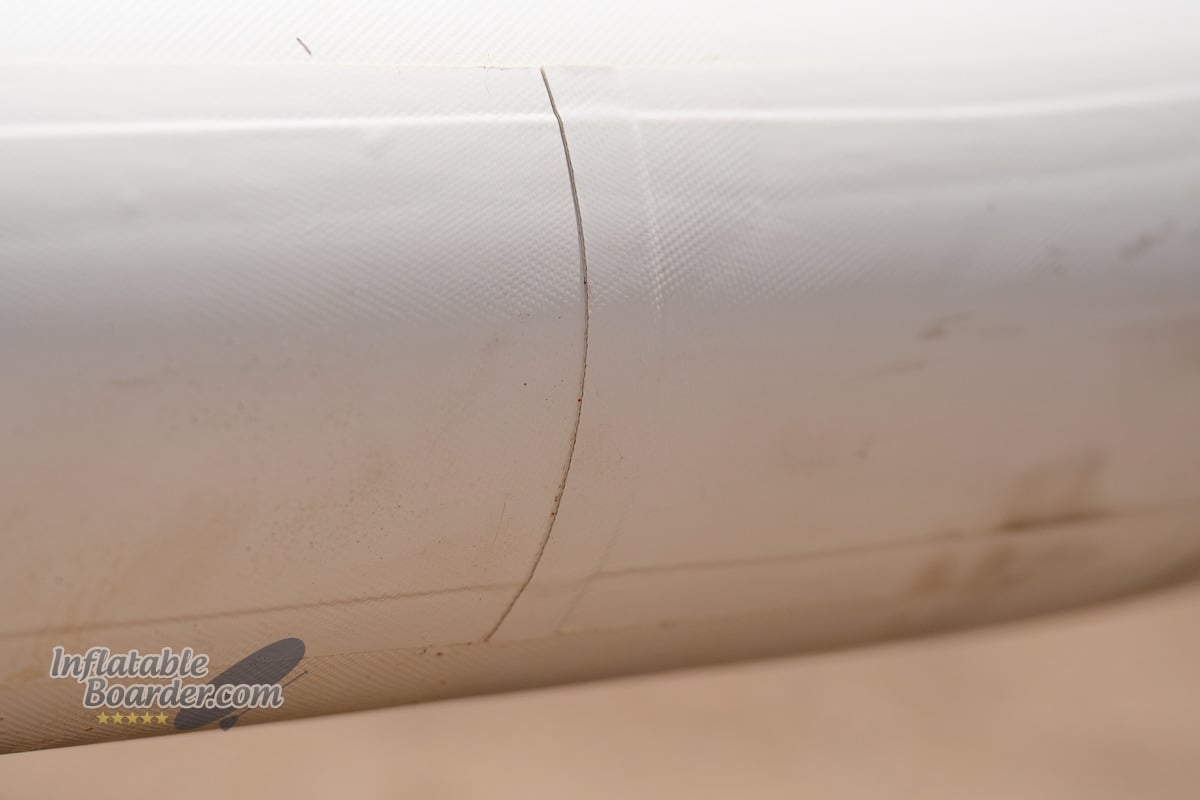
The Tower Yachtsman starts with a standard drop stitch core made of two layers of knitted fabric connected together with thousands of fibers. The yarns that run between the two layers of fabric keep the board flat when it is inflated and set the board’s thickness to be the same 6” across the whole board.
The top and bottom fabric sheets are coated with a layer of PVC to make them airtight and provide some rigidity. Tower then hand-glues a layer of reinforced PVC tarpaulin to this first layer of PVC for additional durability and rigidity. After the second layer of material is cured, the fabric is cut to shape and readied for assembly. The top and bottom layers are brought together and joined by gluing a band of PVC material around the entire edge of the board. This first rail band completes the board’s air chamber. A second layer of PVC rail band is then applied over the first for additional protection and rigidity.
Once the board is built, then the deck pad and other features are glued to the deck and hull for a final weight of around 25 pounds. The Yachtsman is recommended for use at a maximum internal pressure of just 12 PSI.
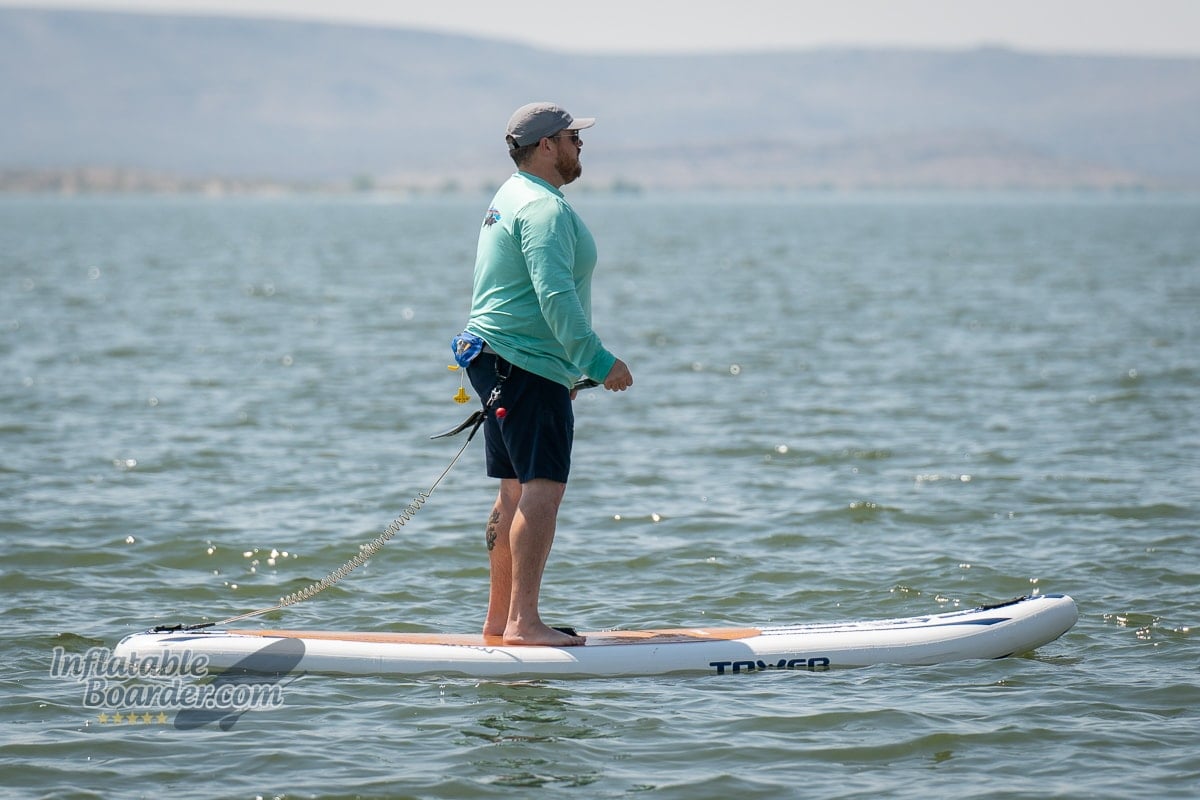
Once inflated to the maximum recommended 12 PSI, we put the Yachtsman through our dry land bend test. We load the board with 170 lbs of weight with a 7’ span between supports under the board and measure how much it bends. The Yachtsman bent 1.73”, or just slightly more than our running average of 1.57”. Considering the Yachtsman is only recommended for 12 PSI, this was a surprisingly good result and in no doubt due to the hand-glued double layer deck and hull.
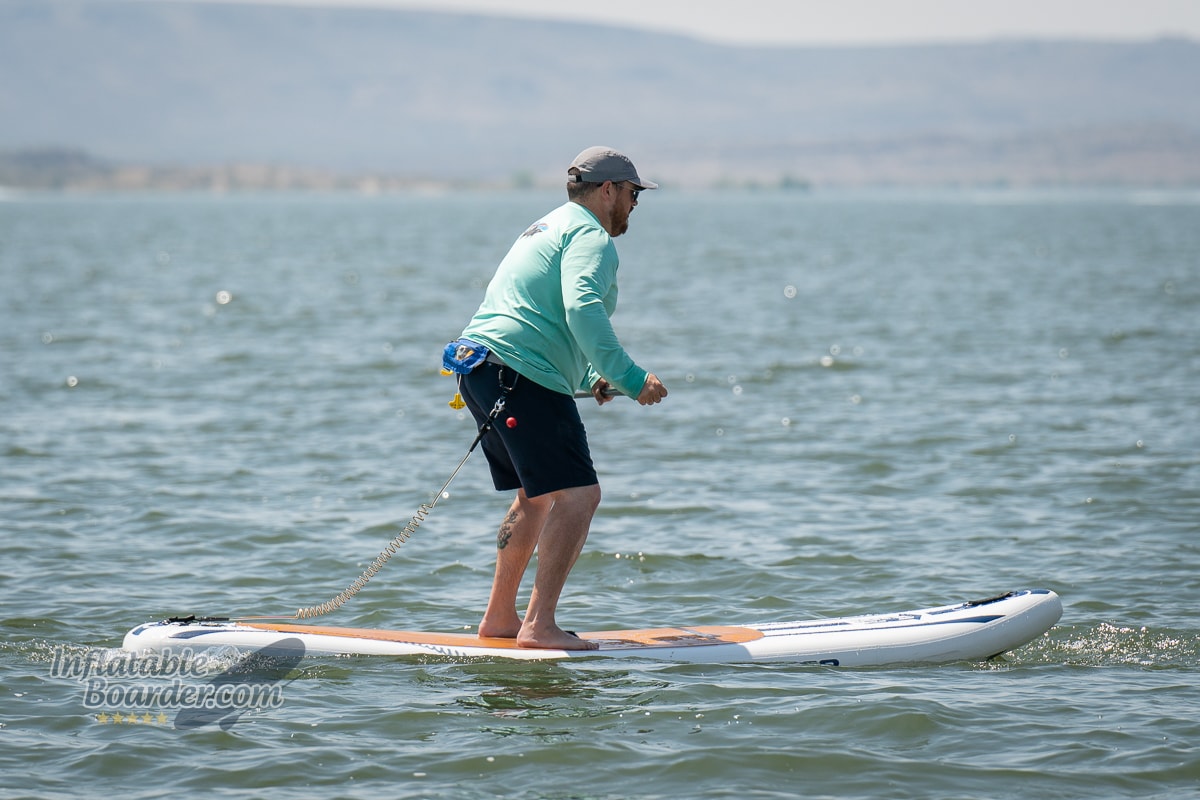
Once out on the water I didn’t notice much flex while standing on the Yachtsman or while paddling at a casual pace. However I did feel some, and as I increased my paddling pace (or moved around on the board) the amount of flex increased and became more noticeable. Once I stopped paddling or moving, the board flattened back out again rather quickly.
Overall the Yachtsman’s construction does lend it to good durability over time, but leaves quite a bit of rigidity on the drawing room table by limiting the recommended internal pressure to just 12 PSI for “Optimal Performance.”
Specifications
| Dimensions | |
| Length | 10’ 4” |
| Width | 32“ |
| Thickness | 6“ |
| Weight | |
| Max Capacity | 400 pounds |
| Board Weight | 25 pounds |
| Kit Weight |
31 pounds |
| Buying Info | |
| List Price | $ |
| Warranty | 2 years |
| Returns period | 30 days |
Features, Accessories and Versatility
The Yachtsman is described as “designed to compliment even the finest boats,” and it definitely seems to be the intent that this is not a full-featured iSUP, but rather one to be used casually near your boat or beach.
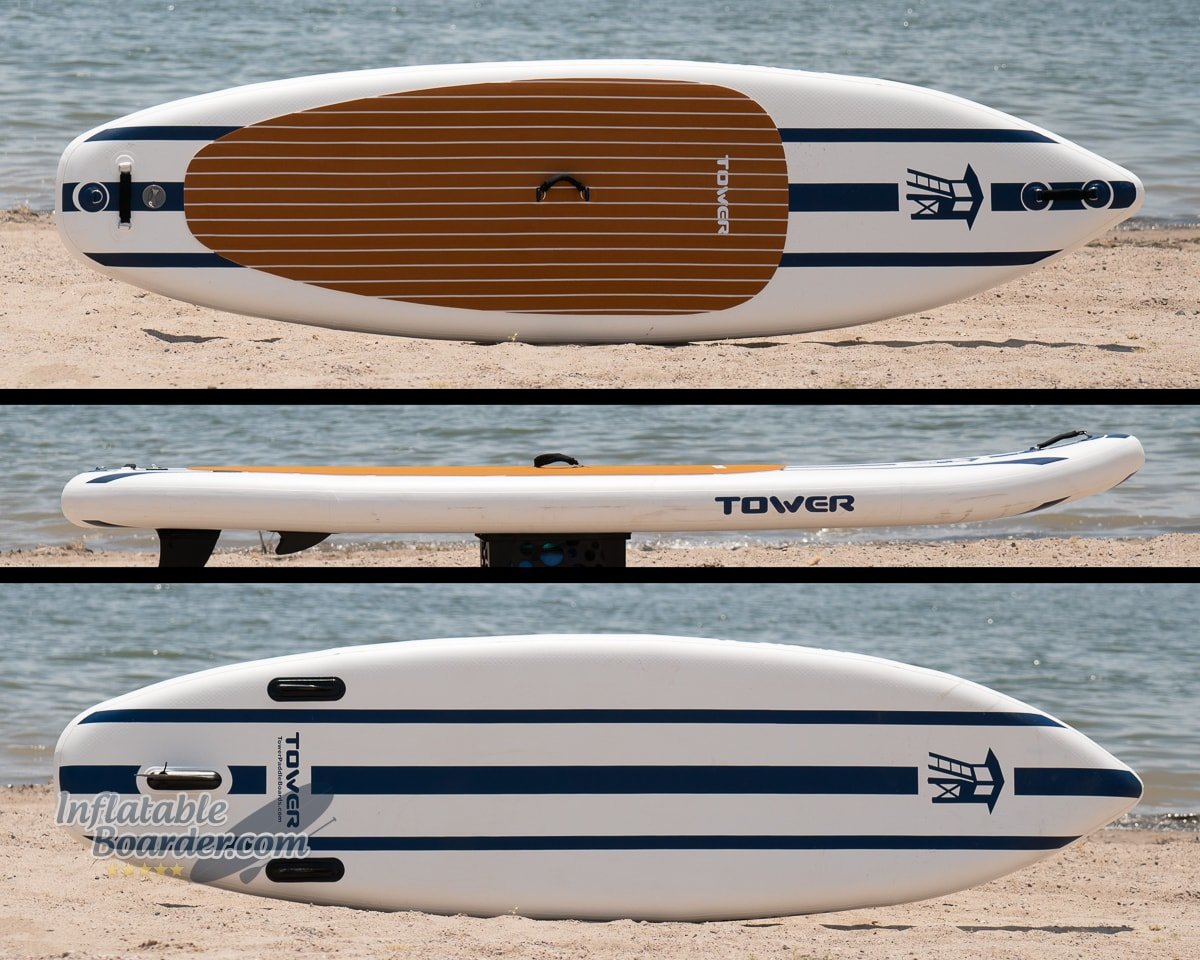
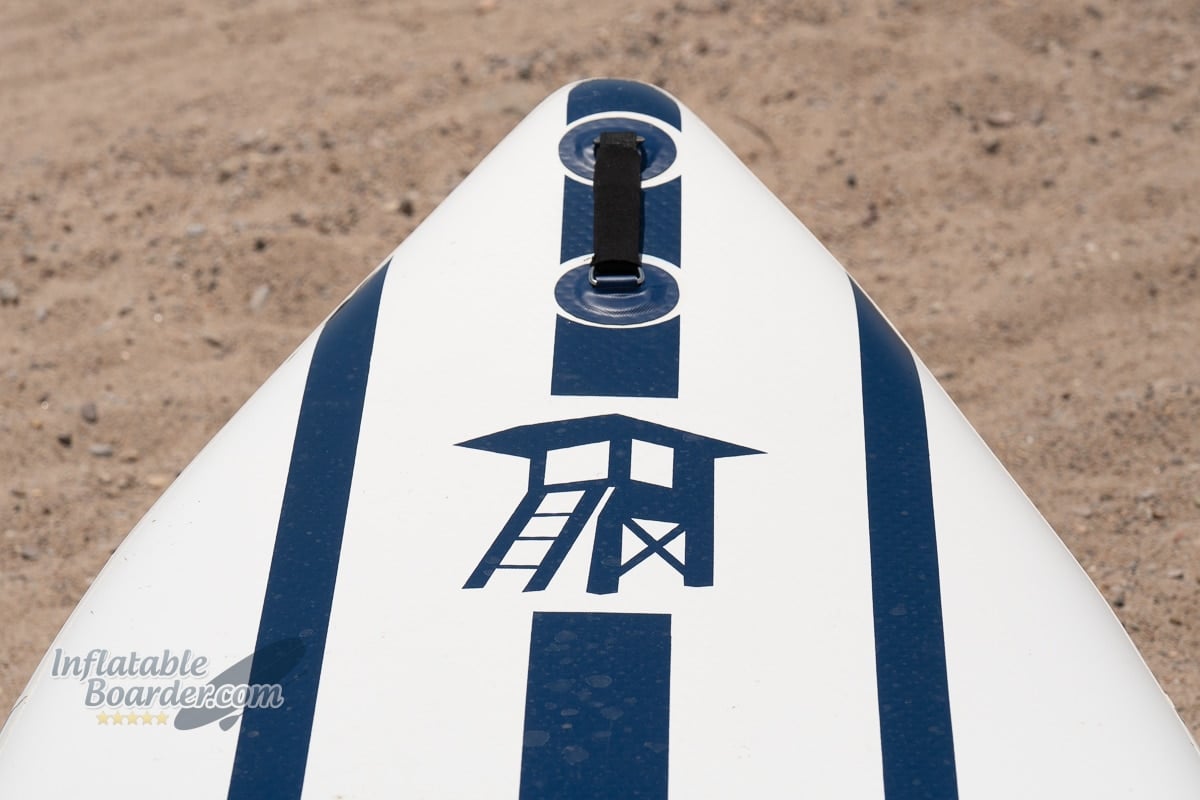
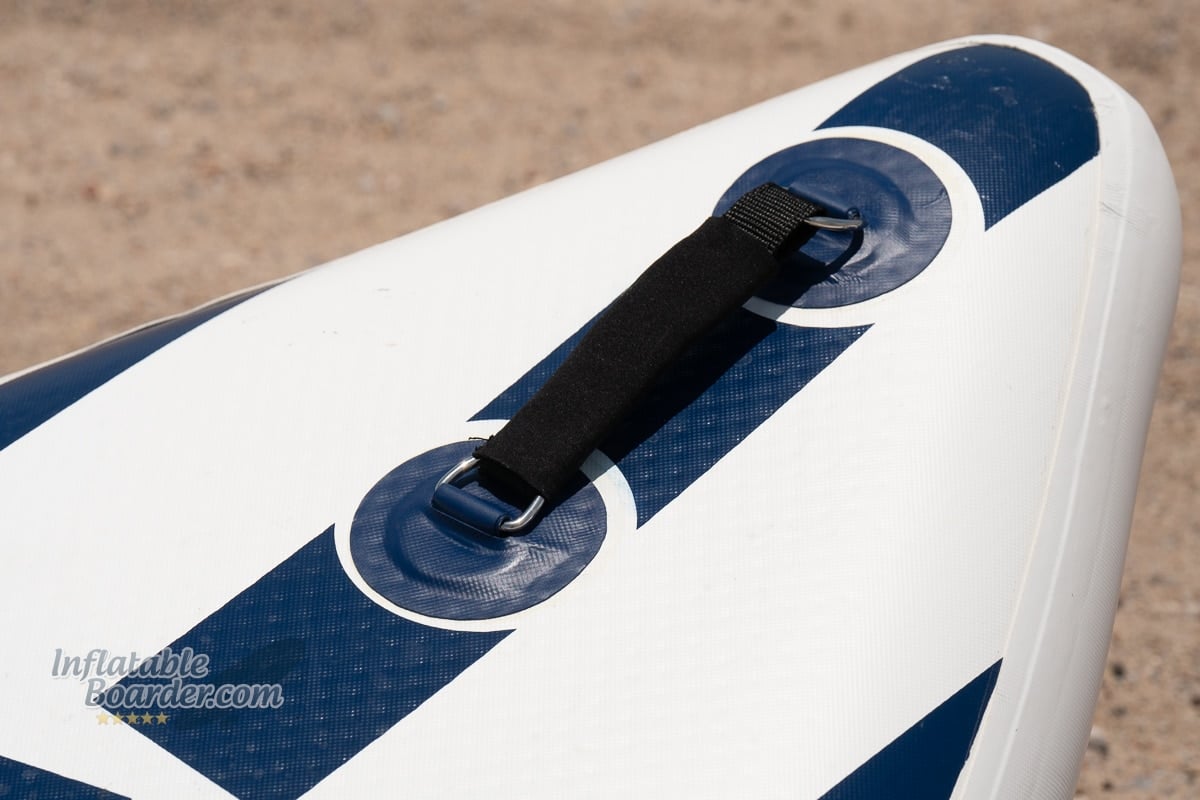
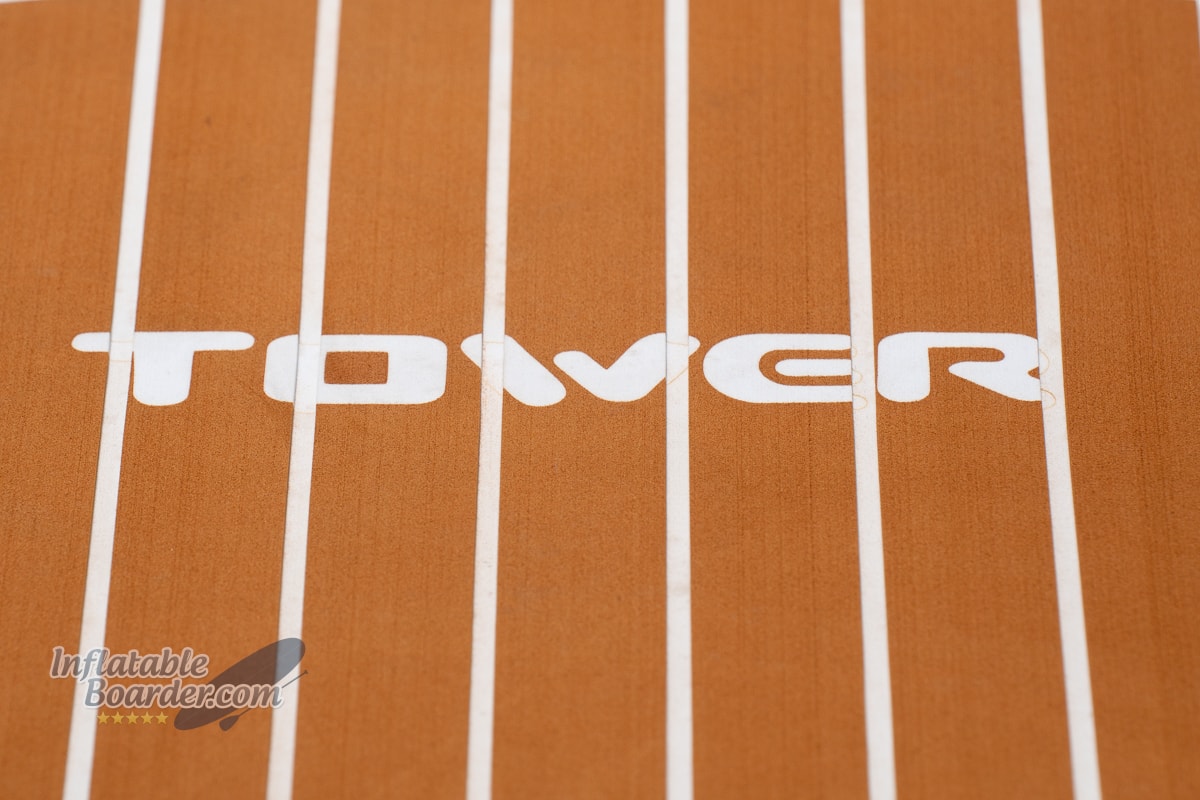
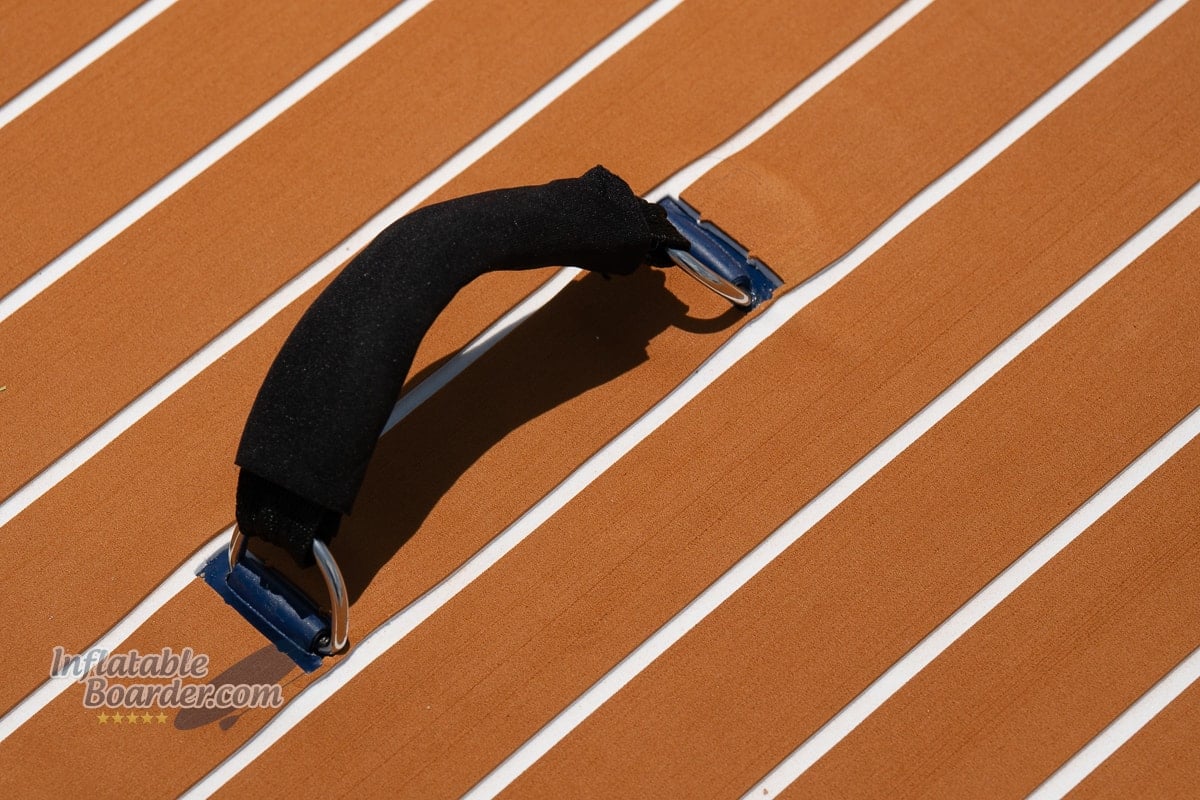
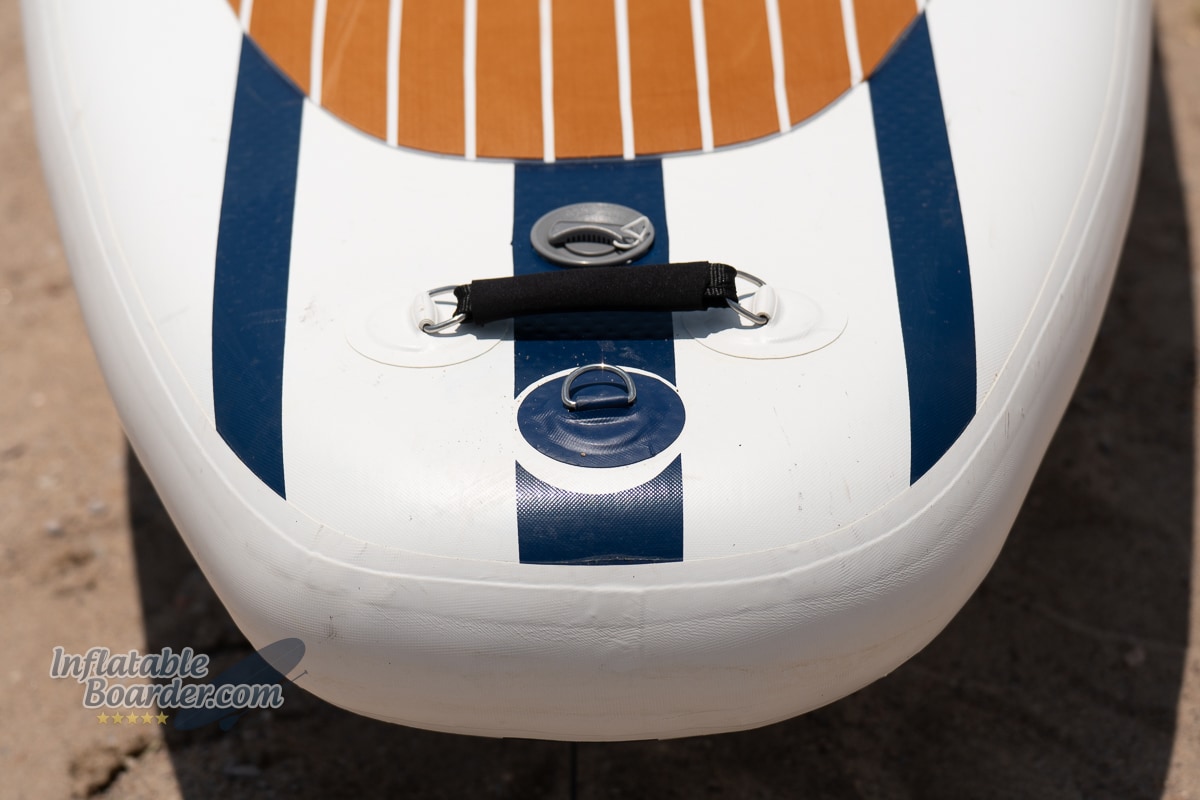
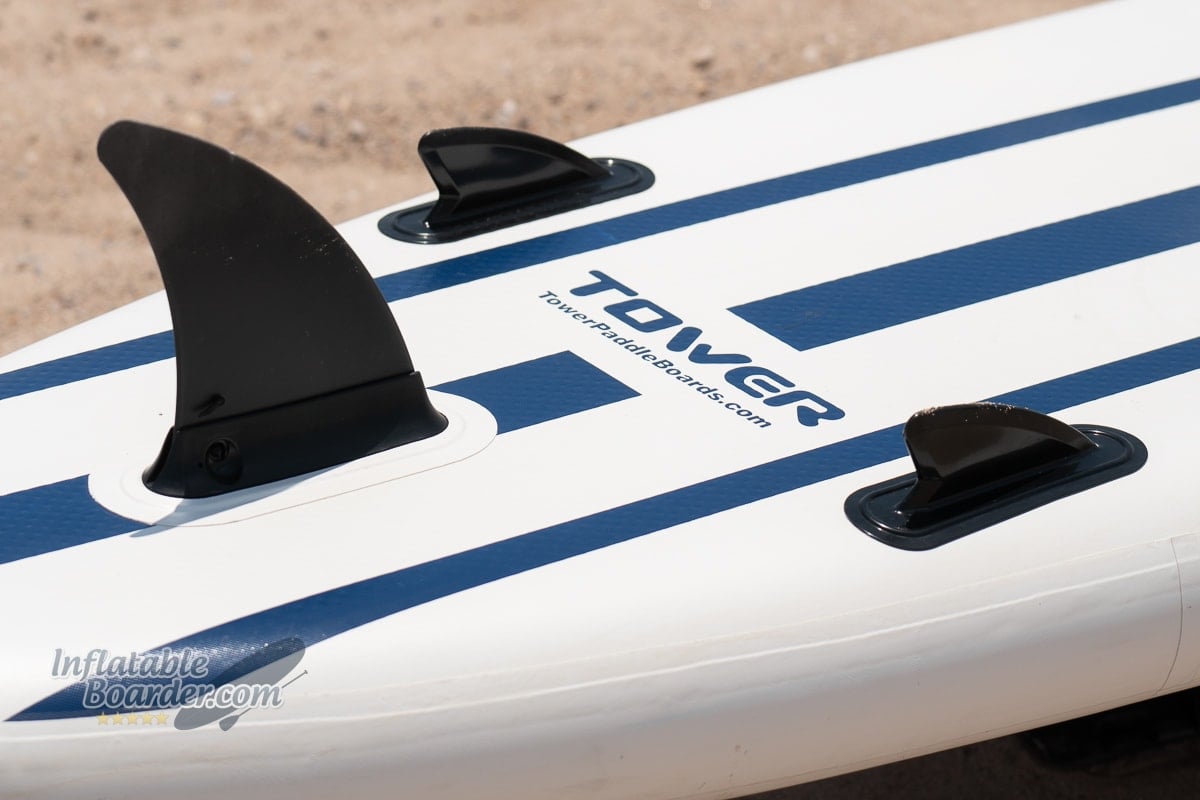
Tower includes a basic accessory kit along with the Yachtsman. Included is a 9” removable center fin, fiberglass/plastic paddle, repair kit, and a single-chamber/single-action hand pump. It does not include a bag for storage and transportation or a leash.

Paddle
Tower’s fiberglass and plastic paddle works well enough for casual cruising over short distances, but is a little underwhelming for iSUP kits in this price range.
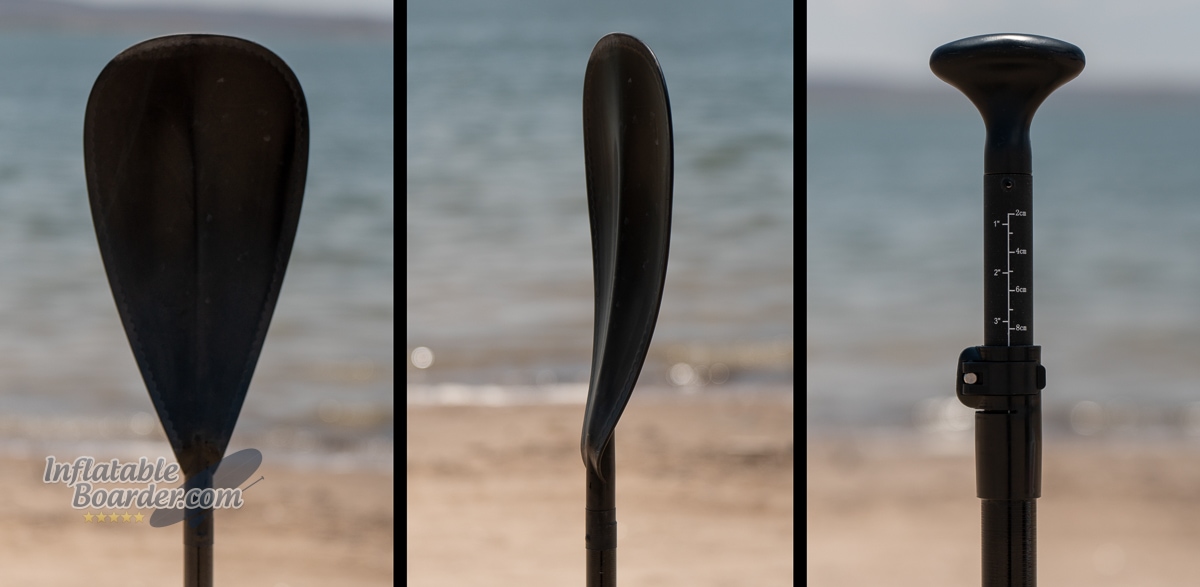
There are many benefits to a fiberglass paddle shaft over an aluminum one. They are lighter, they have more flex for comfortable paddling, and when they flex/bend they do not permanently deform. Not all fiberglass paddle shafts are the same, though. Some are lighter or heavier, some are more flexible or more rigid, etc. The Tower paddle shaft has a medium to high flex. This creates a comfortable paddling experience, but does reduce the efficiency of the paddle as more of your energy goes into bending the paddling rather than moving the paddle board. For casual paddling this is not a problem, and is often more welcome than an extremely stiff aluminum or carbon fiber paddle shaft.
When I first saw the large paddle blade my immediate concern was that it is too large for most paddlers. Larger blades require more effort to paddle with, and can be harder to use for smaller paddlers. However the ABS plastic blade does have a decent amount of flex in it. Like with paddle shafts, flexible blades can provide a more comfortable experience – especially for smaller paddlers – but do so at the loss of power overall.
Overall the Tower paddle has a lot of flex, but is balanced by the large blade for comfortable cruising around. However, it is also a very heavy paddle at 34 ounces. Lifting a heavier paddle over and over again can become tiring, adding up to the equivalent of lifting hundreds of extra pounds per hour.
The handle section of the paddle uses a simple pressure clamp that makes it easy to adjust the tension by simply twisting the clamp lever while it is disengaged. The handle section has a length scale on it to quickly set your desired paddle length, however it does not have any type of indexing so you’ll need to check the handle alignment with the paddle blade each time you adjust the length.
Stability
The Yachtsman has good stability while in calm, flat conditions, however it could benefit from some shaping changes for better stability while in mild (or more severe) conditions.
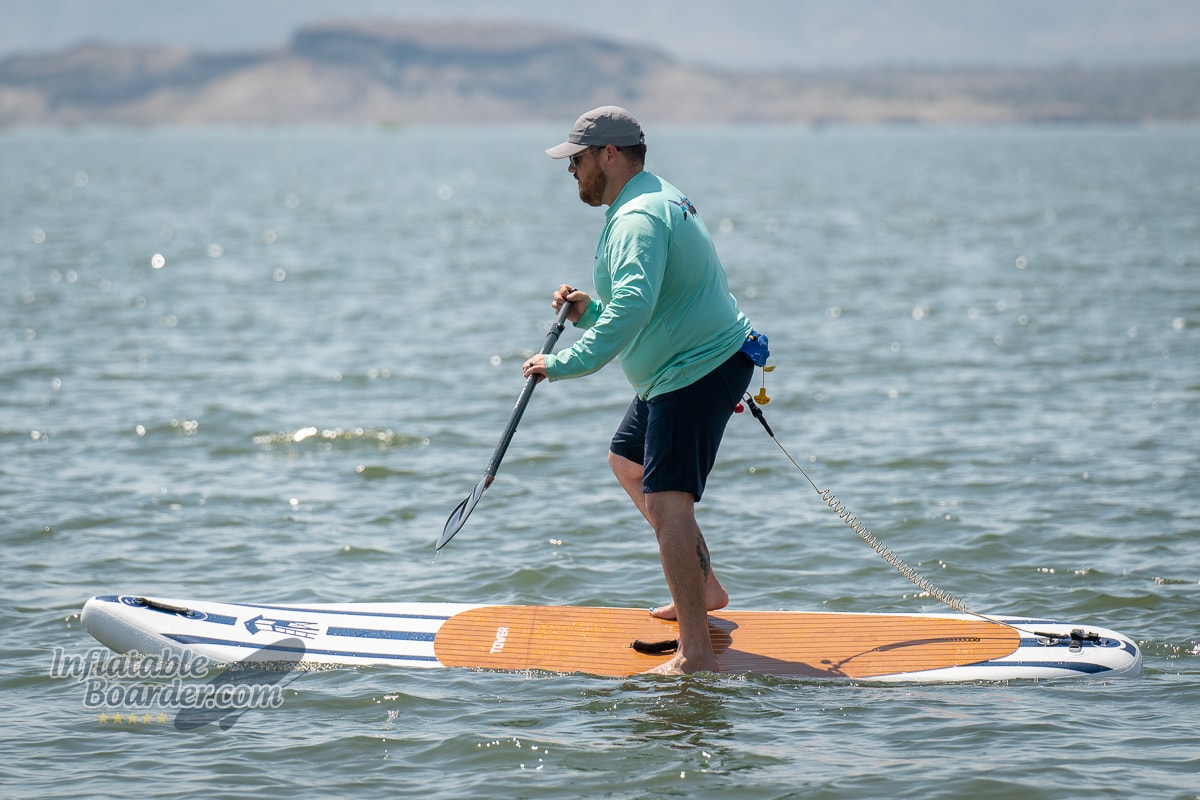
On paper the Yachtsman’s size is extremely similar to many other all-around paddle boards. 10’4” long and 32” wide is pretty close to what I consider to be standard all-around iSUP dimensions. However those numbers alone don’t give you the whole picture – what’s missing is the board’s shape.
The Yachtsman – and Tower’s other all-around iSUPs – all share the same basic outline. There’s a very pointed nose that has a long drawn out arc to the middle of the board and immediately begins to arc back toward a medium-width rounded tail.
This rounded shape can be aesthetically pleasing, but does present some issues with stability. First the widest section of the board is 32” wide, but only for a very short time before tapering in either direction. If you are standing anywhere other than this exact wide point you are standing on a narrower board. This particularly comes into play if you are paddling with a passenger or heavier cargo and need to adjust your position to keep the board level.
The next impact this tapering shape has is it reduces the amount of volume and surface area in contact with the water compared to a more parallel outline. While paddling in very calm conditions this difference isn’t as noticeable, but as soon as there is any amount of swell, wake, or any other disturbance on the water’s surface the Yachtsman becomes much harder to balance on.

While rocking the board around to test its secondary stability (how it feels when it is not flat on the water), I could feel that same tapered shape working against me as well. As the board tapers to each end, when balancing on the rail there is less of the board touching the water than there is with a more parallel shape.
Now, there are tons of design nuances when it comes to shaping a paddle board, and I’m not saying that the Yachtsman should become a rectangular dock. But by allowing that 32” width to exist a little more through the mid section of the board rather than having a continuous curve along the rail, the Yachtsman’s stability would improve greatly in those less-than-ideal conditions.
Speed
The Tower Yachtsman is designed for casual paddling and cruising first and foremost, so it’s neither a surprise, nor a huge negative, that its top speed is relatively low. However it does exactly what it’s designed to, paddle well at casual speeds.

With more of a cruiser vibe coming through in its design, the Yachtsman’s top speed is, not surprisingly, not very high. I was able to sustain sprint speeds of just around 4.9 MPH (7.9 KMH) and reached a peak speed of only 5.1 MPH (8.2 KMH). These lower speeds are partly from the overall shape and shorter length of the board, but more importantly because of flex. The Yachtsman has a significant amount of flex in the board while paddling with more energy which pushes the board down into the water and causes it to turn with each stroke. Additionally, the included fiberglass and plastic paddle is comfortable at cruising speeds, but loses significant amounts of energy while paddling for speed.
However, the Yachtsman is built more like a cruiser than a race board! So how well does it do at a more casual pace? At a comfortable 25 strokes per minute (continuous casual paddling with a slight pause between strokes) the Yachtsman glides along at an average speed of 3.5 MPH (5.6 KMH) which is actually on the faster end of the range for all-around iSUPs. This is the Yachtsman’s forte – casual cruising.
How far a paddle board will travel with a single paddle stroke is what we call the board’s glide. This measurement gives us an insight into the overall efficiency of the board’s design and how easy it is to paddle over longer distances. With each paddle stroke we found the Yachtsman to travel an average of about 16.5 feet before slowing down. This gives it a gliding ratio of 1.6 board lengths per stroke – right where we expect all-around iSUPs of this length to perform and perfectly in line with Tower’s other all-around boards.
Maneuverability and Tracking
The Tower Yachtsman’s shape and fin setup lend it to being a highly maneuverable iSUP, but it does so at the sacrifice of easy straight-line tracking.

Longer paddle boards resist turning more than shorter ones – there’s just more board to “push” through the water. So with a relatively large front nose rocker the Tower Yachtsman’s 10’4” overall length behaves more like a 9’6” board on the water making it very quick to turn.
In our maneuverability stress test we measure how many forward sweep paddle strokes (paddling in an arc from the nose to the tail) it takes to turn the Yachtsman in a complete circle from a standstill. With those forward sweep strokes it takes an average of just 4.5 strokes to spin in a complete circle.
That’s almost 90° per stroke!
The shorter water line and tapered shape combined with the all-around style center fin work together to make the Yachtsman extremely nimble on the water.
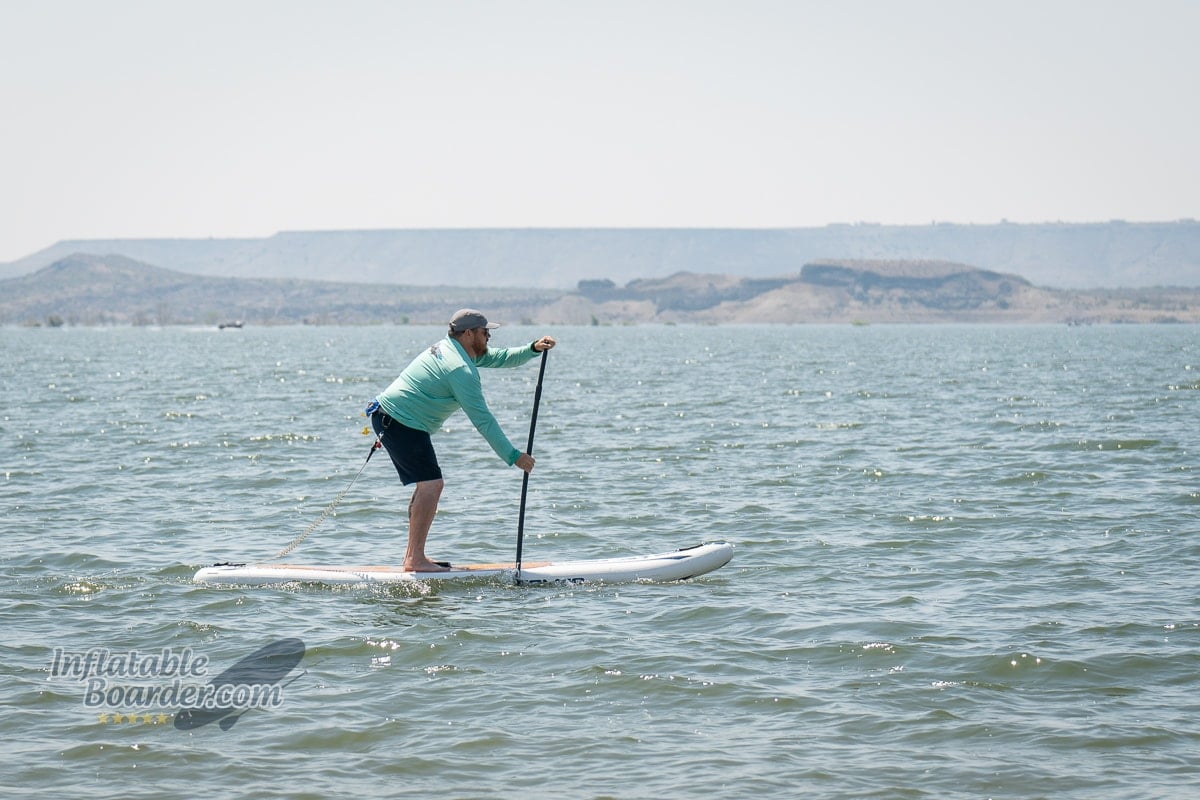
While the maneuverability of the Yachtsman was excellent, its straight line tracking performance was not nearly as good. Frequently these two performance characteristics are directly correlated to each other – as one gets better the other gets worse. In this case it was very difficult to keep the Yachtsman on course.
To measure its tracking ability, we began paddling the Yachtsman toward a distant target and then took 10 high-quality forward strokes on one side of the board. The board’s new course is then measured compared to the original course using a compass. The Yachtsman’s average change in course was 25° in just 10 paddle strokes. That puts it at the lowest end of the range for all-around iSUPs and near the bottom of the list for all of the paddleboards we’ve tested.
While the Yachtsman didn’t do great in our stress test, it does do a little bit better with more standard paddling conditions. During casual cruising it was easy enough to keep the Yachtsman heading in the right direction, but did require a little more steering input or switching sides than normal.
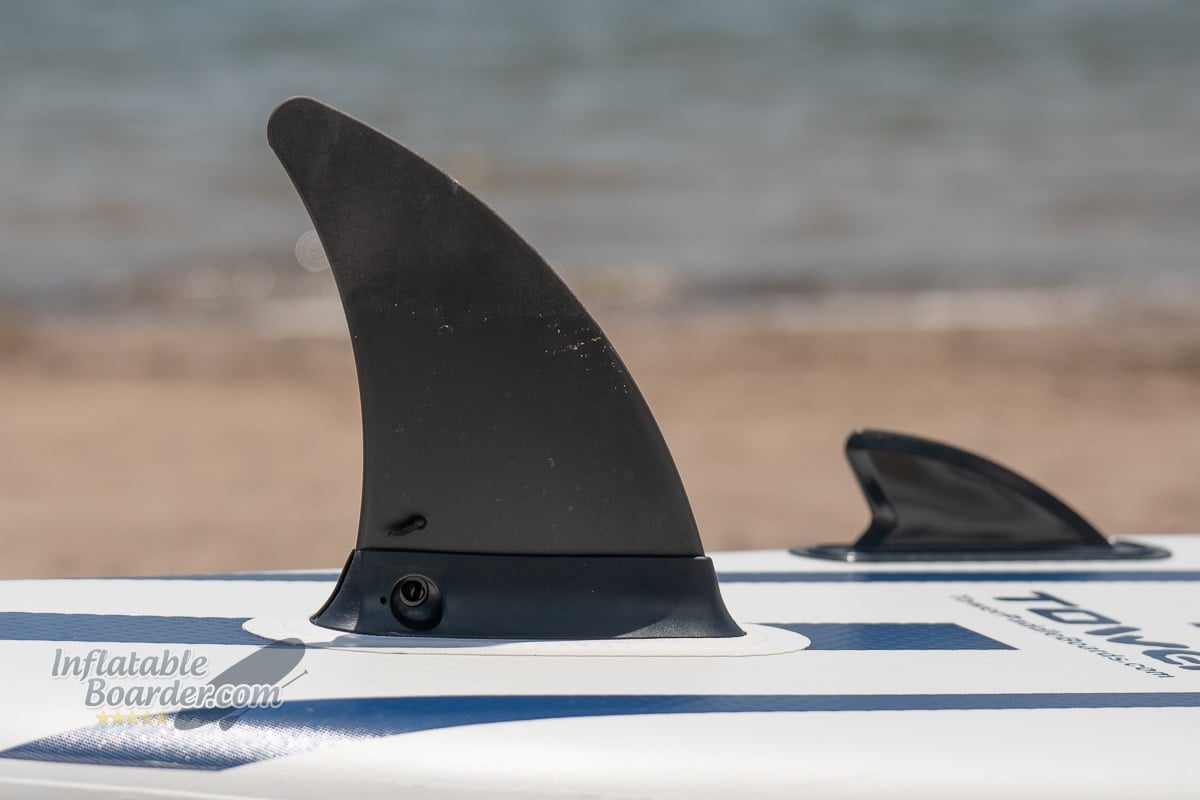
Besides the board’s size and shape, its fin setup plays a crucial role in maneuverability and tracking performance. The Yachtsman has two, small, fixed side fins and one center fin box. In our testing and experience this style of small side fin is purely aesthetic with no real impact on tracking or maneuverability. The vast majority of that work is done by the included 9” center fin. This fin has a “dolphin” shape that’s commonly used with all-around and surf-style SUPs. The wide base provides some tracking support while the narrow tip allows for easier maneuverability – exactly what we see with the Yachtsman’s performance.
The hook-and-pin connection system for this fin box is easy to use (and requires no tools), but has two major drawbacks. The first is durability as the entire system relies on a small plastic pin that is pressure fit into the fin box with each installation and removal. The second drawback is there is effectively no alternative or replacement options for this fin except ordering from Tower. Tower does offer a 4.5” version for paddling in shallow conditions, but if you lose or break your fin it’s not likely you’ll be able to find a replacement or loaner quicker than ordering a new one from Tower.
Warranty and Customer Support
Tower Paddle Boards warranties the Yachtsman and their other “Premium” line iSUPs for 2 years and offers no explicit warranty on any of their accessories. There is a 30-day return window for new/unused boards (less shipping fees). For all of Tower’s insistence on the quality and longevity of their “Premium” iSUPs on their website it’s a bit disappointing to see only a basic 2 year warranty (and none for the accessories). I would like to see them stand behind their product for longer and offer a 3+ year warranty (their “Elite” series iSUPs use the same construction and receive a 3 year warranty). If you have any questions, you can contact Tower via telephone, email, by appointment at their California retail shop, and through social media.
Overall Impressions/Review Summary
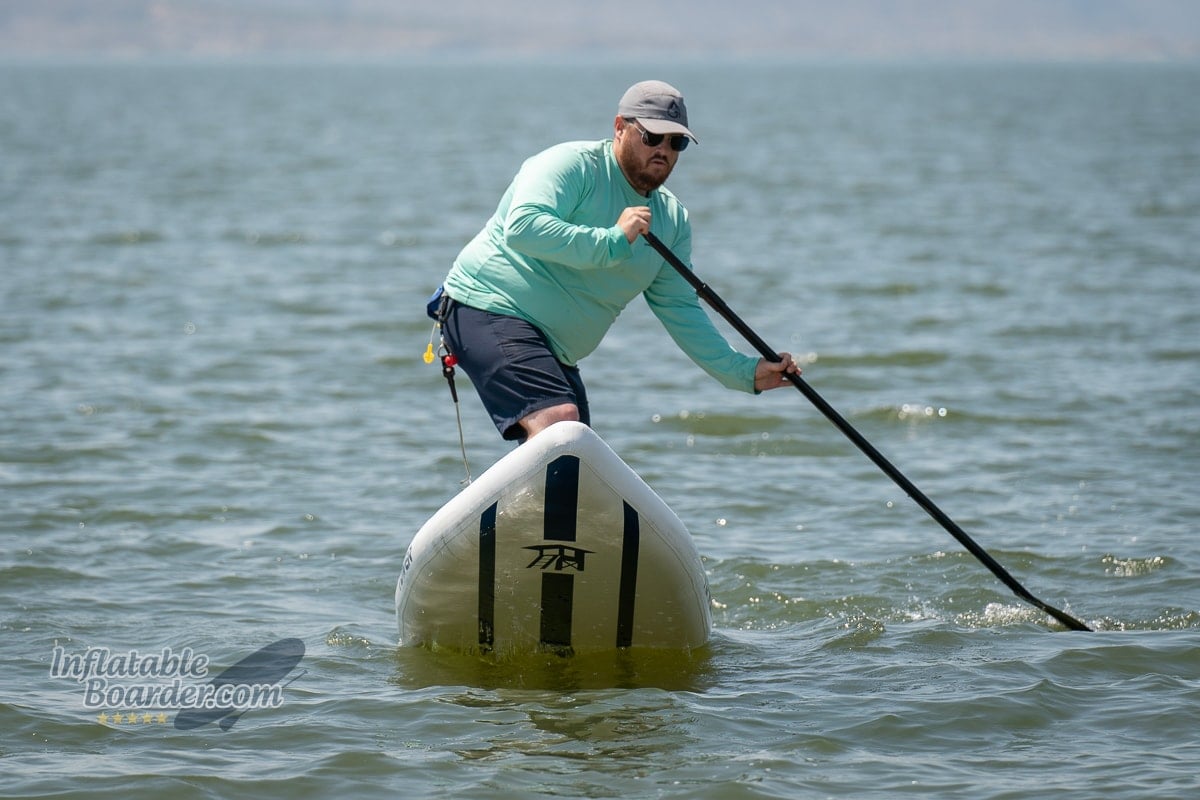
The Tower Yachtsman is an all-around iSUP at heart, but lacks many of the features and abilities we have come to expect in an all-around paddle board. There’s no ability to carry anything with you on the board, and the stability suffers drastically in any conditions other than perfectly calm. The included kit of accessories is not befitting its price tag, and the board’s performance is limited by Tower’s recommended maximum pressure of just 12 PSI for “optimal performance.” A few tweaks to the board’s outline and features (interestingly found on Tower’s other all-around iSUPs, but conspicuously absent on the Yachtsman), an upgraded recommendation to 15 PSI, and a more up-to-date accessory kit would all greatly improve the Yachtsman’s performance and versatility.
Tower Yachtsman iSUP FAQ
Is the Tower Yachtsman iSUP good for beginners?
In calm conditions the Yachtsman can work well for beginners, but its stability does decline with the addition of waves, wake, swell, or chop.
How long does it take to inflate the Tower Yachtsman iSUP?
Using the included single-action hand pump takes 8-10 minutes to inflate the Yachtsman to the recommended 12 PSI, however smaller paddlers may find the hand pump difficult to use above 8-10 PSI.
Can I use the Tower Yachtsman iSUP with a kayak seat?
No, the Tower Yachtsman is not compatible with kayak seats.
Can I paddle with kids or pets on the Tower Yachtsman iSUP?
Yes, you can paddle with smaller kids or pets on the Yachtsman, however the board’s stability will change as you move forward or backward to adjust for the extra passenger.

